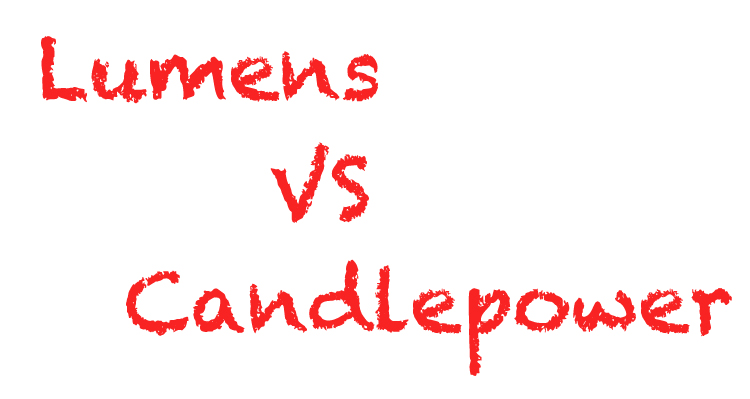Candlepower Compared to Lumens
We get this question all the time: what’s the difference between lumens and candlepower?
The short answer about lumens vs. candlepower:
Candlepower is a measure of the brightest part of the beam of a flashlight whereas lumens is a measure of the total amount of light put out by a flashlight. A good example demonstrating the difference between lumens and candlepower is the laser. Lasers have a very high candlepower because the light is focused into a single point, but it would have a very low lumen value because it does not give off a substantial amount light. You certainly would not want to go on a walk in the woods at night with a laser pointer.
The longer answer for candlepower compared to lumens:**
All light measurements can be traced back to the Candela, which is the unit of luminous intensity. The Candela is also sometimes called candlepower, and is similar to an older unit, the candle, which was based upon an actual candle of specified dimensions and construction.
There are two basic methods used by various flashlight manufacturers to rate the light output of their products.
Total Luminous Output may be expressed in candela or in lumens. This is a measure of the entire light output of the flashlight regardless of beam focus. It is almost solely a function of the lamp, and for practical purposes is equal to the lamp output which lamp manufacturers rate in Mean Spherical Candela (Sometimes called Mean Spherical Candlepower which is not the same as peak beam intensity), or in lumens. Multiply candela by 12.57 to convert to lumens. For example, the 20 watt lamp used in the SL-35X is rated at 450 lumens or 35.8 Mean Spherical Candela.
Peak Beam Intensity (Candlepower) is a measure of the brightest spot in the focused beam. It is a function of both the output of the lamp and the efficiency of the reflector. The focused spot of light has the same intensity that a bare source of unfocused light of the same candlepower would produce on the same area from the same distance. For example, a flashlight of 20,000 beam candlepower would project, within its “hot spot,” the same amount of light on a wall as would a bare lamp of 20,000 candela at the same distance. Typical values of beam candlepower will run into the tens of thousands for powerful rechargeable flashlights.
Since the Total Output system does not take into account the focusing efficiency of the reflector, there is no way to convert between peak beam candlepower and lumens.
Additionally, all light rating systems depend on the perception of the human eye and are therefore subjective. Another important factor besides absolute intensity is the whiteness (technically the Color Temperature) of the light source. If two equally intense light sources differ in color temperature, the eye will perceive the whiter source (higher color temperature) to be brighter than the more yellow one. Color temperature is expressed in degrees on the Kelvin scale. A very white flashlight lamp will be rated around 3200 K.*
In an effort to standardize performance measurement, the American National Standards Institute (ANSI) with input from various flashlight manufacturers, developed performance standards and symbols to effectively measure and communicate a flashlight’s features and benefits including brightness, runtime, beam distance, peak beam intensity, protection against water penetration and impact resistance. Streamlight, Pelican, Energizer, Maglite, Nite Ize (Inova), Fenix, Bayco and Petzl are now rating their new models using the ANSI Standards. This will make is easier to compare flashlights across these brands.
*Streamlight, “Information about how the brightness of a light (luminosity) is measured.”, http://www.streamlight.com/releases/light_measurement.htm (accessed January 25, 2005).
**Information from http://www.brightguy.com/page/brighttopics
Click here to visit BrightGuy.com. BrightGuy stocks over 450 types of flashlights and is an authorized distributor for Streamlight, SureFire, Fenix, Underwater Kinetics, Princeton Tec, Petzl, LED Lenser, Pelican, and more.

